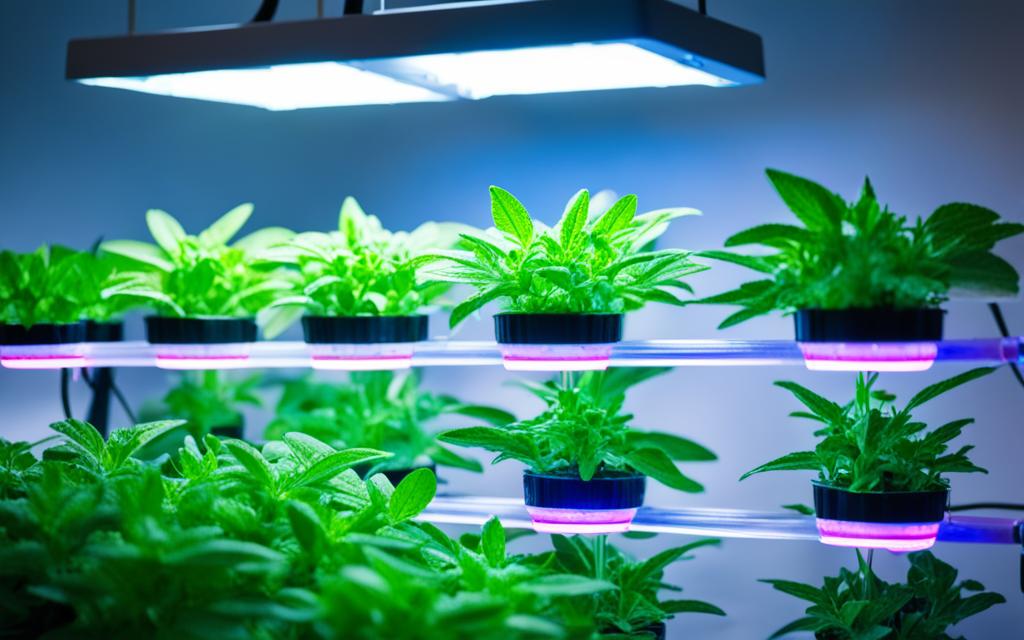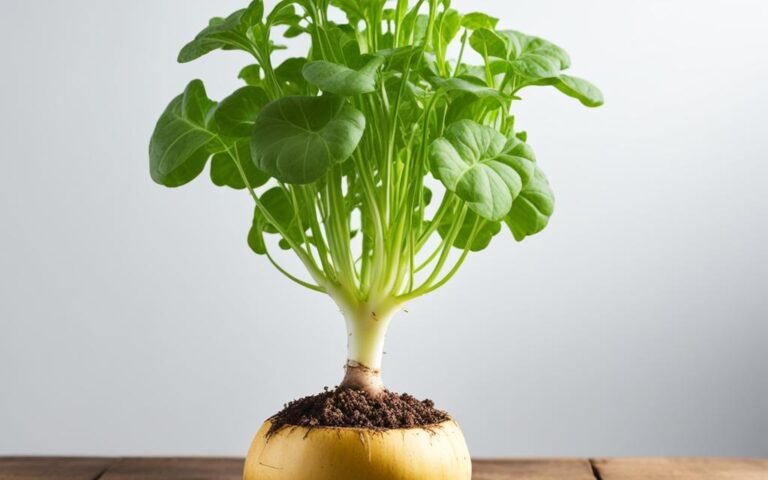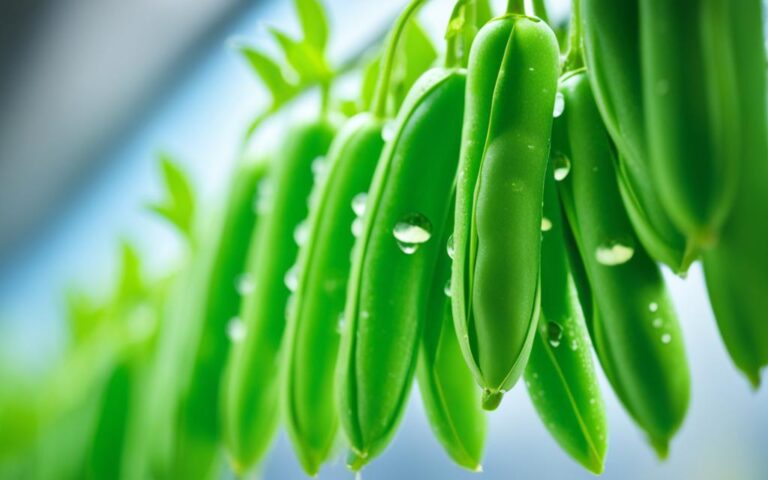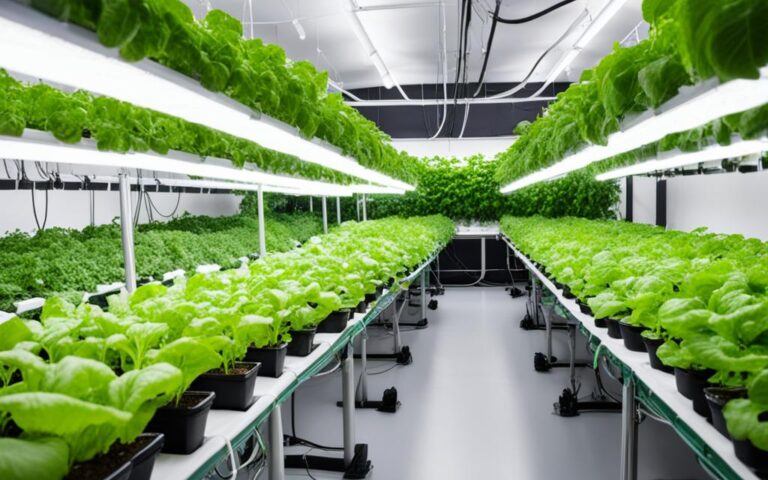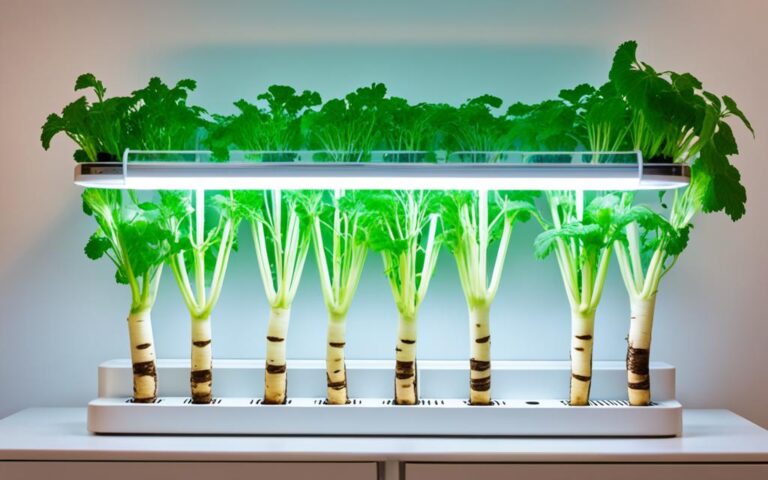Hydroponic Sage Growing Guide & Tips | Cultivate Now
Did you know hydroponic sage can give you up to 30% more than growing it in soil? Learn how to grow this versatile herb indoors without soil. This guide will show you how to set up and keep a hydroponic sage garden. You’ll learn about the best equipment, nutrients, and how to keep the environment right.
Key Takeaways
- Hydroponic sage cultivation can increase yields and enhance flavor and nutritional content compared to soil-based growing.
- Properly setting up your grow tent and selecting the right hydroponic system are crucial for success.
- Carefully managing light, temperature, humidity, and nutrient solution are key to optimizing sage plant health.
- Identifying and addressing common issues, such as nutrient deficiencies and pest/disease management, will ensure a bountiful harvest.
- Hydroponic sage offers a sustainable, space-efficient solution for indoor herb gardening enthusiasts.
Introduction to Growing Sage Hydroponically
Growing sage hydroponically opens new doors for indoor gardeners and herb lovers. This method lets you control the environment for faster growth, more yields, and better flavor. You can enjoy this herb all year, right at home.
Hydroponic sage gardening is exciting for anyone. It uses nutrient-rich water instead of soil, giving you control over the plants. This means faster growth, more harvests, and a deeper flavor that makes your cooking better.
Whether you’re experienced or new to indoor gardening, growing hydroponic sage is rewarding. By learning the right techniques and what this herb needs, you can create a lush indoor garden. This brings the garden’s freshness right to your kitchen.

Benefits of Hydroponic Sage Cultivation
Growing sage with hydroponics has many benefits over traditional soil gardening. It leads to faster growth and better nutrition. This method uses a controlled environment to make the herb grow well.
Faster Growth Rate
Hydroponic sage grows much faster than soil-grown sage. It can grow twice as fast. This is because hydroponics deliver nutrients directly and control the environment. This means the plants mature quicker and you can harvest more often.
Higher Yields
Hydroponic sage plants produce more than those grown in soil. They have access to rich nutrients and the best growing conditions. This leads to a steady and reliable harvest. It’s great for both commercial growers and gardeners at home.
Improved Flavor Profile
Hydroponic sage is known for its amazing taste and quality. The clean water and balanced nutrients help the plants develop a deeper flavor. They produce a richer, more fragrant herb.
Enhanced Nutritional Content
Hydroponic sage is full of essential oils, vitamins, and antioxidants. The precise nutrient delivery in hydroponics ensures the plants get exactly what they need. This results in a herb that tastes great and is very nutritious.
“Hydroponic cultivation unlocks the full potential of sage, delivering a faster-growing, more productive, and nutritionally superior herb.”
Getting Started with Hydroponic Sage
Starting your sage grow tent is key to growing this fragrant herb indoors. First, set up the poles and connect them to form the tent’s frame. Then, cover the tent with a reflective canvas to boost light and help your plants grow.
Setting Up Your Grow Tent
Put LED grow lights at the top of the tent and make sure they’re secure. These lights are vital for your sage’s growth. For air flow, use an intake fan at the bottom and an exhaust fan at the top. Adding a small fan inside helps keep air moving and stops mold.
Essential Equipment
You’ll also need other hydroponic sage equipment for a great growing space. This includes hydroponic solution, a water pump, growing media, and tools to check nutrient levels. With these items, you’re ready to grow healthy hydroponic sage indoors.
“By setting up the right hydroponic sage setup, you can enjoy a bountiful harvest of this flavorful herb year-round, right in the comfort of your own home.”
Hydroponic System Selection
Choosing the right hydroponic sage systems is key for growing sage well. You can pick from deep water culture, ebb and flow, or nutrient film technique. Each method has its own benefits and things to think about. Make sure to pick the one that fits your space and your level of expertise.
When looking at hydroponic sage growing systems, think about how you’ll manage water and nutrients. Also, consider how you’ll get oxygen to the roots and the system’s complexity. Talking to experienced growers or using trusted resources can help you choose the best hydroponic system for sage plants.
Hydroponic systems have many benefits for sage, like:
- Faster growth rates
- Higher yields
- Improved flavor profile
- Enhanced nutritional content
By picking the right hydroponic sage systems, you can get a healthy and plentiful harvest of this fragrant herb.
“Hydroponic gardening is a game-changer for sage cultivation, offering unparalleled control and precision in nutrient delivery and environmental conditions.”
Seed Starting and Transplanting
Cultivating hydroponic sage starts with careful attention during seed germination and transplanting. Whether you begin with seeds or move seedlings, getting these steps right is key for a successful hydroponic sage garden.
Seed Germination
Hydroponic sage seeds need special care to germinate well. Begin by soaking rockwool cubes in pH-balanced water for an hour before planting. This prepares the environment for the seeds to grow.
Put 2-3 hydroponic sage seeds in each cube to boost your chances of getting at least one seedling. Keep the area warm and humid, as these conditions help with hydroponic sage seed germination. Germination takes 10 to 21 days.
Transplanting Techniques
When the sage seedlings have strong roots, it’s time to move them to your hydroponic setup. Be gentle with the stems and make a small hole in the medium. Place the rockwool cube with the seedling into it carefully. Good hydroponic sage transplanting methods are vital for your plants to thrive.
By using the best methods for starting hydroponic sage from seeds and transplanting, you set the stage for a successful hydroponic sage garden. This will give you plenty of harvests and great flavor.
Environmental Factors for hydroponic Sage
Cultivating hydroponic sage needs careful attention to the right environment. This includes lighting, temperature, humidity, and managing the nutrient solution. Each factor is key for healthy, tasty sage plants.
Light Requirements
Hydroponic sage needs lots of consistent light. It should get 14 to 16 hours of hydroponic sage light every day. This light should be strong and similar to the bright, sunny days in its native Mediterranean.
This long, quality light helps the plants grow strong. It also makes sure they have the best aroma and taste.
Temperature and Humidity
Keeping the right hydroponic sage temperature is crucial. Daytime should be between 70-75°F (21-24°C), and nights should be 60-65°F (15-18°C). This temperature change helps the plant taste better.
Also, the hydroponic sage humidity should be 40-50%. This keeps the environment perfect for growth without mold or mildew.
Nutrient Solution Management
The hydroponic sage nutrient solution must be watched closely. It should have an electrical conductivity (EC) of 1.0 to 1.6. The pH should be between 5.5 and 6.0.
“Proper environmental control is the key to cultivating thriving, flavorful hydroponic sage.”
Nutrient Management for Hydroponic Sage
Looking after your hydroponic sage plants means managing their nutrients well. Sage needs a mix of nitrogen, phosphorus, and potassium for growth and health.
Essential Nutrients
The best nutrient mix for hydroponic sage has an N-P-K ratio of 10-5-14. This mix is good for all stages of the plant’s life. It helps with healthy leaves, strong stems, and tasty leaves.
pH and EC Levels
Keeping the right pH and EC levels in the nutrient solution is key for sage’s health. The ideal pH is between 5.5 and 6.0. This helps the plant absorb nutrients better.
The EC, which shows nutrient strength, should be 1.0 to 1.6. This prevents giving the plant too much fertilizer.
“Proper nutrient management is the foundation for thriving hydroponic sage plants.”
By watching and adjusting the hydroponic sage nutrients, hydroponic sage pH, and hydroponic sage EC, you can help your sage grow well. This way, you get to enjoy fresh, tasty herbs from your own garden.
Common Issues and Troubleshooting
Growing hydroponic sage is rewarding, but gardeners may face challenges. Issues like hydroponic sage nutrient deficiencies and hydroponic sage pests and diseases are common. It’s important to know how to handle these problems to keep your plants healthy.
Identifying Nutrient Deficiencies
Hydroponic sage issues often involve nutrient imbalances. Signs like yellow leaves, slow growth, or color changes mean your plants might lack nitrogen, phosphorus, or potassium. Keep an eye on your plants and adjust the nutrients as needed to help them grow well.
Pest and Disease Management
Even in a controlled hydroponic setup, hydroponic sage can get pests or diseases. Pests like powdery mildew, leaf spot, and aphids are common. Good air flow, careful watering, and using natural pest control can help prevent and fix these hydroponic sage troubles.
By being watchful and dealing with problems quickly, you can keep your hydroponic sage plants healthy and flourishing.
Harvesting and Storing Hydroponic Sage
Hydroponic sage is a rewarding crop that offers bountiful harvests throughout the growing season. To ensure you make the most of your homegrown hydroponic sage, it’s essential to understand the optimal harvest time and proper storage techniques.
Optimal Harvest Time
Sage grown hydroponically is quite generous when it comes to harvest time. Once the plants reach around 6 inches in height, they are ready for their first trim. Regular harvesting encourages more growth, so aim to snip less than a third of the plant at a time to keep it healthy and productive.
For the best hydroponic sage harvesting experience, harvest in the morning after the dew has dried but before the sun is at its highest. This is when the essential oils are most concentrated for maximum flavor.
Preserving Sage for Future Use
When it comes to hydroponic sage storage, there are several options to preserve your bountiful harvest. You can keep the fresh leaves vibrant in the fridge by wrapping them in a moist paper towel and placing them in a plastic bag.
For longer-term storage of hydroponic sage, you can dry the leaves by hanging bunches upside-down in a dark, well-ventilated area. Once dry, strip the leaves from the stems and store them in an airtight container.
Sage can also be frozen by chopping and freezing the leaves in ice cube trays filled with water. This ensures you can enjoy the flavor of your hydroponic sage all year round.
“Proper harvesting and storage techniques are key to making the most of your hydroponic sage crop. With a little care, you can enjoy the fresh, flavorful leaves throughout the year.”
Expanding Your Hydroponic Garden
Once you’ve learned how to grow hydroponic sage, think about expanding your indoor garden with other herbs and leafy greens. Hydroponic systems can hold many plants, like crisp lettuces, vibrant kales, fragrant basil, and cilantro. Trying out different hydroponic-friendly crops can add new flavors and textures to your cooking. It also makes your indoor growing setup more diverse.
Adding more plants to your system can make the most of hydroponic gardening. You’ll get a lot of fresh, tasty produce all year. Look into growing more in your hydroponic system and adding to your hydroponic garden. This way, you can make a lush, useful indoor garden.
Expanding Your Crop Selection
Think about adding these plants to your garden:
- Leafy greens (e.g., lettuce, kale, spinach)
- Aromatic herbs (e.g., basil, cilantro, mint)
- Tomatoes, peppers, and other fruiting vegetables
- Edible flowers (e.g., nasturtiums, violas)
Each plant brings new tastes, textures, and nutrients to your homegrown food. This lets you cultivate a diverse and abundant hydroponic garden.
| Crop | Ideal Hydroponic Conditions | Estimated Yield Increase |
|---|---|---|
| Lettuce | 6-8 hours of light, temp 65-75°F, pH 5.5-6.5 | 25-50% higher yields |
| Basil | 6-8 hours of light, temp 68-86°F, pH 5.5-6.5 | 30-60% higher yields |
| Tomatoes | 8-12 hours of light, temp 68-86°F, pH 5.5-6.5 | 40-80% higher yields |
By expanding your hydroponic garden, you can have fresh, tasty, and healthy produce at home.
Comparing Hydroponic and Soil-Grown Sage
There are big differences between growing sage hydroponically and in soil. Hydroponic sage grows in water full of nutrients, offering many benefits over soil-grown sage.
Hydroponic sage grows much faster than soil-grown sage. It can grow up to twice as fast. This is because it gets nutrients directly and is in a controlled environment.
Hydroponic sage also produces more per plant than soil-grown sage. The rich water and perfect conditions in hydroponics mean more plants and better yields.
| Factors | Hydroponic Sage | Soil-Grown Sage |
|---|---|---|
| Growth Rate | Faster, up to 2x | Slower |
| Yields | Higher | Lower |
| Flavor Profile | Enhanced | Standard |
| Nutrient Content | Richer in essential oils, vitamins, and antioxidants | Varies based on soil quality |
Hydroponic sage tastes better and is of higher quality. The clean water and perfect nutrients in hydroponics make the herb more flavorful and vibrant.
Hydroponic sage is full of essential oils, vitamins, and antioxidants. It gets exactly what it needs from the nutrients, making it more nutritious than soil-grown sage.
“Hydroponic sage cultivation offers a clear advantage in terms of growth rate, yields, flavor, and nutritional content compared to traditional soil-grown methods.”
Health Benefits of Sage
Sage is a fragrant herb used in cooking and medicine. It’s known for its health benefits. This plant has compounds that can improve our health.
One teaspoon of sage gives you 10% of the daily Vitamin K you need. It’s important for blood clotting and bone health. Sage also has iron, vitamin B6, calcium, and manganese, which are key for health.
Sage is full of antioxidants like rosmarinic acid and carnosic acid. These can fight off harmful free radicals. They might lower the risk of some cancers and boost brain function and memory.
Preliminary research suggests sage could be a natural mouthwash. It might prevent plaque and cavities.
Studies show sage could help with insulin resistance and blood sugar levels. It might also lower bad cholesterol and raise good cholesterol. More studies are needed, but sage looks promising for health.
“Sage is not only a flavorful culinary herb but also a potent source of beneficial compounds.”
Sage is versatile, with both medicinal uses and nutritional value. It’s a health-promoting herb. As research continues, sage is proving to be valuable in health-conscious kitchens and gardens.
Varieties of Sage Plants
Sage, also known as Salvia, is a versatile herb with many varieties. It suits different needs and tastes. From the popular Common Sage (Salvia Officinalis) to the bright Ornamental Sage types, there’s something for everyone.
Common Sage
The Common Sage (Salvia Officinalis) is the most known and used type. It has soft, silvery-green leaves and purple-blue flowers. You can use its leaves fresh or dried to flavor dishes. There are also sub-varieties like a dwarf plant, purple garden sage, golden sage, tricolor sage, and Berggarten sage, each with its own look.
Ornamental Sage Varieties
Culinary sage is key in many kitchens, but ornamental sage plants are just as beautiful. They come in various colors, shapes, and sizes. Popular ones include Pineapple Sage, Grape-Scented Sage, Scarlet Sage, and Mealycup Sage. These sages make gardens look great and attract butterflies and hummingbirds.
| Variety | Characteristics | Uses |
|---|---|---|
| Common Sage (Salvia Officinalis) | Soft, silvery-green leaves and purple-blue flowers | Culinary, medicinal |
| Pineapple Sage | Vibrant red flowers, pineapple-scented leaves | Ornamental, culinary |
| Grape-Scented Sage | Grayish-green leaves with a distinctive grape aroma | Ornamental, culinary |
| Scarlet Sage | Bright red, tubular flowers | Ornamental, medicinal |
| Mealycup Sage | Fuzzy, gray-green leaves and purple-blue flowers | Ornamental |
If you want to add culinary sage to your cooking or ornamental sage to your garden, there’s a sage for you. Check out the different types to see which fits your needs and tastes.
Propagating and Caring for Sage
Sage can be easily grown from seeds or cuttings from a mature plant. Growing sage from seeds or propagating sage from cuttings both require careful attention for success.
Growing Sage from Seeds
Start sage seeds in spring after the last frost, or indoors 6-8 weeks before. Seeds germinate in 10-21 days. Seedlings are ready for transplanting in 5-6 weeks.
Propagating Sage from Cuttings
Sage propagation through cuttings means you get new plants just like the original. Cut a 4-6 inch stem from a healthy plant. Remove lower leaves and plant it in good soil or a rooting medium.
Choosing how to propagate sage matters less than proper caring for sage plants. Ensure they get enough sunlight, well-drained soil, and consistent water. This way, they’ll grow well and reach their full potential.
“Propagating sage is a rewarding way to expand your herb garden and share the flavorful plant with friends and family.”
Indoor vs Outdoor Sage Cultivation
Growing sage indoors or outdoors has its perks. For those into sage hydroponics, an indoor grow tent is perfect. It lets you control light, temperature, humidity, and nutrients. This leads to faster growth, higher yields, and better flavor and nutrition than outdoor methods.
Outdoor sage growing works well in places with a Mediterranean climate. It needs a sunny spot with good drainage and should be spaced 18 inches apart for air flow.
Keeping sage plants moist and trimmed is key to their health and productivity. Knowing the pros and cons of indoor and outdoor growing helps growers choose the best method for their hydroponic sage or outdoor plants.
“Sage is a versatile herb that can be grown both indoors and outdoors, allowing gardeners to choose the environment that best suits their needs and preferences.”
Pests and Diseases in Sage Plants
Sage plants, whether grown hydroponically or in soil, face pests and diseases. One big issue is powdery mildew, a fungal disease. You can fight it with neem oil, sulfur dust, or Bacillus subtilis.
Leaf spot is another problem, often from too much water or splashing water on leaves. To avoid this, make sure air moves well, water in the morning, and don’t water from above.
Crown gall, a bacterial disease, can also hit sage plants. It causes light-colored bulges on the plant. To prevent it, avoid hurting the plant and keep growing conditions right.
By watching closely and acting fast, hydroponic sage growers can beat sage pests and sage diseases. Using hydroponic sage pest management and hydroponic sage disease control helps keep your hydroponic sage garden healthy.
“Identifying and addressing pests and diseases early on is crucial for the success of any hydroponic sage operation.”
Common Sage Pests and Diseases
- Powdery mildew
- Leaf spot
- Crown gall
Preventive Measures
- Use neem oil, sulfur dust, or Bacillus subtilis to manage powdery mildew
- Maintain proper air circulation and water early in the day to prevent leaf spot
- Avoid wounds and keep growing conditions optimal to prevent crown gall
Conclusion
Growing hydroponic sage is both rewarding and exciting. It lets you have this fragrant herb all year in your indoor herb garden. Using soilless sage cultivation means you get faster growth, more plants, better taste, and more nutrients than with soil.
This guide has given you the knowledge and tools for a successful hydroponic sage growing journey. It covered setting up your grow tent, picking the right hydroponic system, and solving common problems. Now, you’re ready to grow your indoor garden and see what’s possible with soilless cultivation. Remember, the fun is in the process, not just the end result.
Happy growing! With what you’ve learned, you’re set to grow healthy hydroponic sage plants. Enjoy their fresh taste and health benefits. Dive into the world of indoor herb gardening and discover the benefits of soilless sage cultivation.
